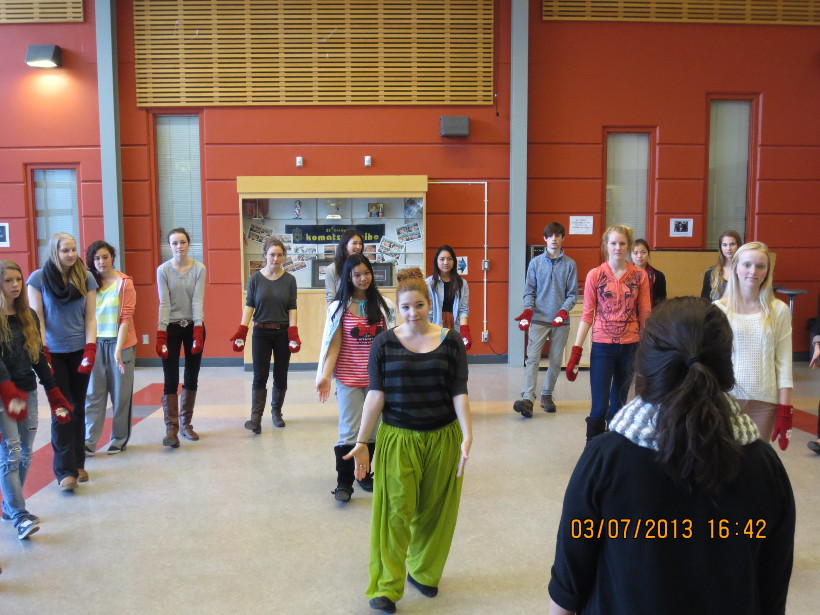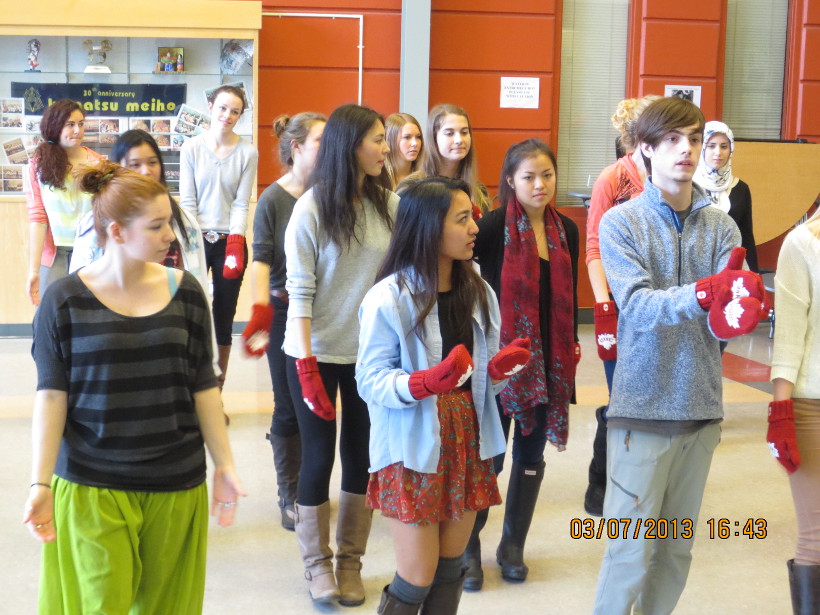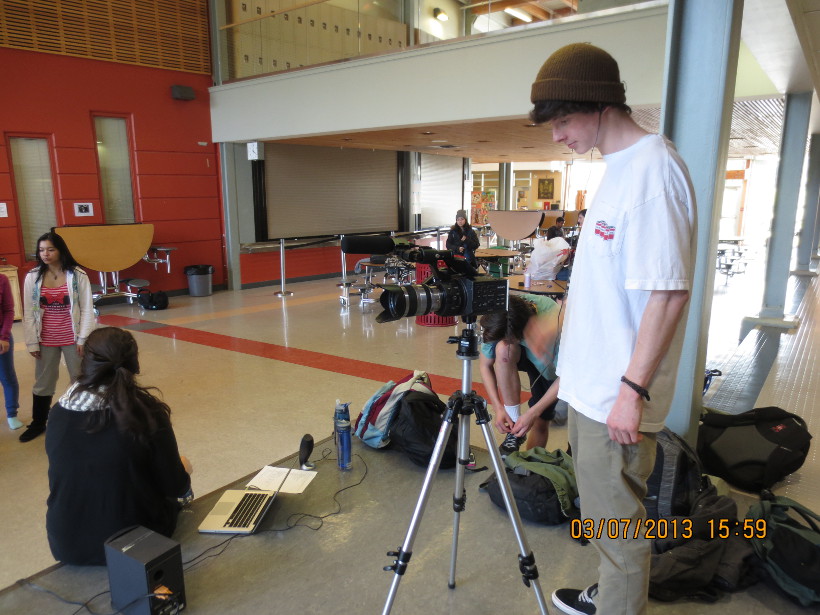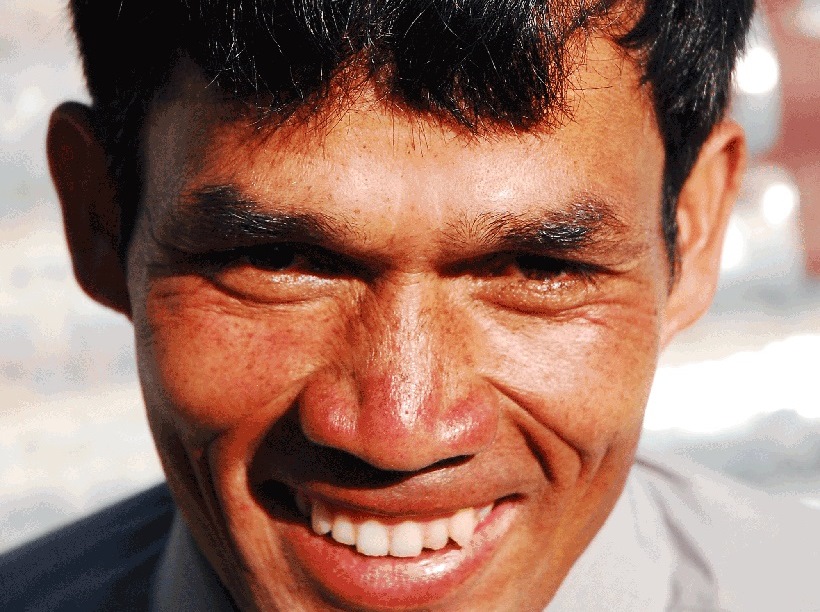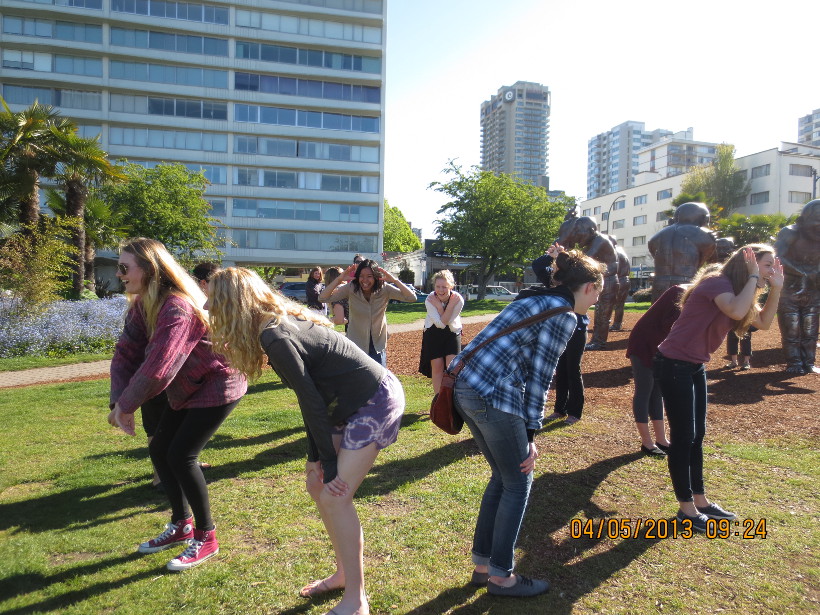Sutherland Gr 12
Arts Education, Social Studies
School:
Sutherland Secondary, North Vancouver, BC
Teachers:
Cynthia Bunbury, Rita Noack, Alexa Smith
Artist:
Manuela Sosa
Class:
Social Justice Class, Photography, Digital Media (Grades)
Sources of Inspiration:
Vancouver Biennale Legacy: A-Maze-ing Laughter
Social Justice Cultural exchange with Nepal
TED Talk: JR Inside Out Challenge
Overview:
Inspired by the international scope of the A-Maze-ing Laughter sculpture, and by the power that art has to connect us with our basic human expression, the students at Sutherland created an interdisciplinary performance piece. During their experience in Nepal, the students learned how freedom of expression differs from one culture to another, and this deepened their understanding of (Minjun’s sculpture), since much of his work is in reaction to the repression of artistic expression in China. While travelling, laughter was often the only language that was mutually understood. Upon their return to Vancouver, the students incorporated the lessons learned abroad, and presented their Nepali-inspired dance piece on location, amongst the laughing figures. Just as (Minjun’s sculptures) take on different meanings depending on where they are and who is viewing them, our performance evolved and transformed as it traveled from one cultural space to another. In addition, selected students documented the multi-phased process and are creating a film about their experience.
BIG IDEAS:
Connections through Artistic Expressions
Guiding Questions:
How does art connects us one to another? How do we celebrate the universality of laughter through art? What do we learn through making cross social and cultural connections and exchange?
Curriculum Access:
Digital Media, Photography, Social Justice, Drama, Dance, Social Studies
Learning Process:
The project began with the collaboration of three disciplines: Photo, Social Justice, and Digital Media. In preparation for a Canadian cultural presentation at the Sutherland sister school in Nepal, the students explored the concept of culture (Canadian and Nepali) and how it is expressed. Following a brainstorming session, the students conceived and embodied these cultural representations. During this exploration the students often responded with spontaneous fits of laughter. Thus, the universal language of laughter became a central focus.
Student Creations:
In addition to the live, interactive performance on site at the A-maze-ing Laughter sculptures, the Digital Media students created a film Connection through Laughter to capture the essence of laughter as a universal language in Nepal and Vancouver. The film includes portraits taken in Nepal and Vancouver. The film was shared with parents and teachers during a celebration film and dinner event at school.
Taking Action:
The goal was to create a multi-media, multi-disciplinary presentation showcasing the power of performance to cross cultural and social boundaries. By sharing the experiences gained abroad in Nepal the team continues to raise awareness about the needs of students and teachers in developing countries around the world. Specifically, the students hope to take action by promoting and getting more people involved in the fundraising effort of premiering a student-created film about the BIG IDEAS process at the school award ceremony in June.
Timeline:
Jan
- Teacher attended Biennale BIG IDEAS Sharing Big Ideas Session
- Finalized collaboration concept and artist collaborator
Feb
Cultural (Re)presentation
Students brainstormed as a class and wrote down all the songs, images, sports, arts etc. that they feel are representative of Canadian culture. After a movement warm-up and some ensemble building exercises, the students were led through a workshop in traditional Nepalese dance. Finally, in small groups the students incorporated the images of Canadian culture, the Nepali dance moves and other parameters designed to encourage creativity into a one-minute cross-cultural presentation that they then performed for the class. Select students filmed the workshop session.
Mar
Non-verbal Communication
After a warm-up, the students were led through various exercises that force them to communicate non-verbally. They were introduced to the elements of Viewpoints performance training. Finally they were encouraged to apply the Viewpoints technique and worked as a group to refine their Cultural Presentation. The workshop session was recorded on film by students.
Apr
Freedom of Expression and Censorship
The students discussed their international experience with the artist, teachers and other participating students. The students discussed the Big Idea and brainstormed how to put their ‘Art in Action.’ After a more in depth presentation of (Minjun’s) A-maze-ing Laughter, the students were encouraged to find parallels between their experience in Nepal and the sculptures. Then, in small groups, they created short performances using the images of the sculptures, ideas freedom of expression and other parameters as inspiration.
May
Perspective and Connection
Field Trip to A-maze-ing Laughter sculpture by (Yue Minjun, China)
Students explored the sculptures and shared their initial reactions. After a discussion about the challenges of the performance space and a review of Viewpoints elements, the students created movement sequences responding to the sculpture within groups. They were encouraged to explore personal and physical perspectives to discover how to best connect with their audience. The session was recorded on film by students.
Art in Action: Final Rehearsal
The students continued their discussion about how they envision their performance. They were encouraged to keep finding connections between the cultural exchange, the sculptures and the Big Idea. The students brainstormed ways to combine all their generated material, and plan their performance. The artist worked together with the students to finalize and rehearse the performance.
Reflections:
Artist(s): It was a privilege to collaborate with the Vancouver Biennale on my first BIG IDEAS experience! I was glad to learn more about an organization that, like me, believes in the importance of arts education, and their refreshingly innovative approach to teaching encouraged me to be (extra) creative in planning the dance/theatre workshops.
The students and teachers at Sutherland Secondary responded with energy and enthusiasm. Naturally, some were more eager to be on stage than others; however, it was most rewarding to see the ‘non-theatre kids’ taking risks and participating in activities that were out of their comfort zone. Many of the students had already felt what it was like to be out of their comfort zone during their cultural exchange in Nepal, and the act of performing helped push this learning experience even further. It takes courage to perform in front of others, in public places, and even more so when representing your country abroad. Nevertheless, the students were able to connect with each other and with their audience. Although the final performance went really well, I am happy to say that, in our case, it was just a step on an ongoing artistic process.
This multi-layered, multi-phased project did not come without its challenges. Whenever you try to coordinate schedules with three institutions, five instructors and over thirty busy students, it’s always a game of give and take. That’s the beauty of collaboration, and I am very proud and grateful to have been a part of such a great learning experience for all involved!
Students:
What do you most want to tell people about your experience in Nepal?
“I want to tell people how amazing, loving and forgiving the Nepali people were. How no matter if I was rich and white, people couldn’t wait to share with me, talk with me, or even just smile at me. Our differences didn’t matter.”
“The amount of positivity and happiness.”
“How happy everyone is there no matter what they have or who they are.”
Why do we laugh?
“Happiness, surprise, evilness, to relieve tension, for comfort, to express joy and discomfort. Laughing is a very natural, spontaneous reaction.”
“We laugh because it’s easier to laugh than cry. We get amused, we giggle nervously, and we cover up the fact that we actually couldn’t care less with laughter.”
“In moments of joy, when you’re overwhelmed”
“Because of a joke, nerves, or someone’s actions”
“We laugh as relief from our serious life and emotions… and to gain energy.”
“We laugh when we find something funny, to mock someone or something, and sometimes when we are scared or ‘screwed’.”
“Art and laughter act as a way to break through cultural barriers in order to connect with one another.”
Judging by your personal experience, how does freedom of expression differ from culture to culture?
“What may be normal and acceptable in one country may not be as usual in another… Like boys holding hands, dancing in the street, singing loudly. In this way people in Nepal actually have more freedom of expression than we do here.”
“[Min Jun’s] work relates to us because his art expresses how he feels and ours will do the same.”
How does all this relate to our Big Idea?
“Because [laughter] is what signals connection.”
Related Material
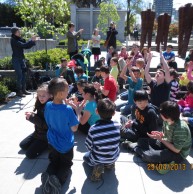 BIG IDEAS in Social Responsibility Part 2
BIG IDEAS in Social Responsibility Part 2